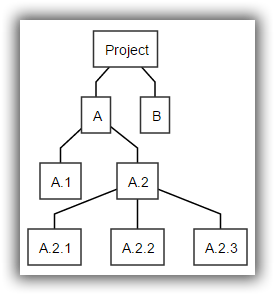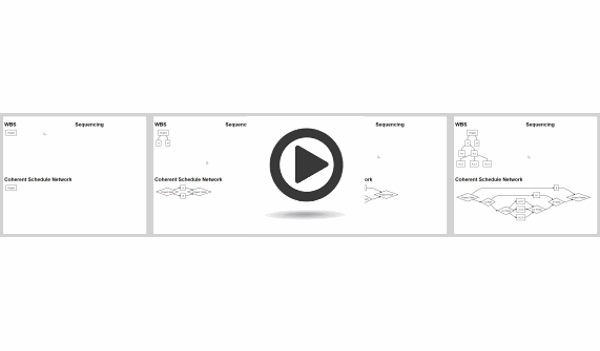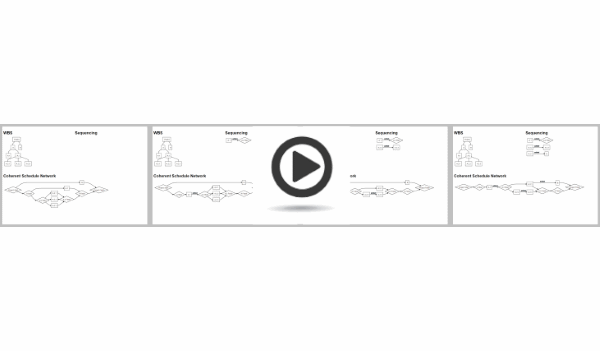 (Article published first in “The Critical Path”, PMI Sydney, February 2015)
(Article published first in “The Critical Path”, PMI Sydney, February 2015)
As argued in a previous article[1], common definitions of œdeliverable in the WBS and schedule network may be maintained by having œStart and œFinish milestones in the schedule network for each WBS summary component. This article introduces a œSchedule Network 100 percent Rule and the œAdd and Prune Dependencies Algorithm by which we can automate this coherence between the WBS and schedule network at project scale. The Schedule Network 100 percent Rule is applied to a WBS to derive an initial schedule network. Required dependencies are then added to the initial schedule network and redundant dependencies are pruned, using the newly introduced œAdd and prune dependencies algorithm. The result is a sequenced schedule network that is coherent with the WBS. A following article will introduce open source software that implements this algorithm and supports the progressive elaboration of a project plan under rolling wave planning.
The 100 percent rule
The Schedule Network 100 percent Rule allows us to construct an initial, fully connected, schedule network based solely on the WBS. The well-known WBS 100 percent rule states[2]: œThe next level decomposition of a WBS element (child level) must represent 100 percent of the work applicable to the next higher (parent) element. Both the WBS and the schedule network are œmaps of the same territory and use different visual languages to represent the deliverables of the project. This article introduces[3] the Schedule Network 100 percent Rule which may be stated as: œA summary activity’s start milestone must precede, and its finish milestone must succeed, 100 percent of the work applicable to the summary activity.

Diagram 1. Sample WBS
Let’s apply the Schedule Network 100 percent Rule to the sample WBS in Diagram 1.
We create a schedule network with œStart Project and œFinish Project milestones before, and after, 100 percent of the project’s work. We place Start and Finish milestones before, and after, 100 percent of A’s work, and before and after A.2’s work. The result is a fully connected, but unsequenced, schedule network (Diagram 2.) that is coherent with the WBS
Schedule Network 100% Rule animation
Click on the play button for a step-by-step animation of and example application of the Schedule Network 100% Rule.

Add and Prune Dependencies
The new[4] Add and Prune Dependencies Algorithm allows us to automatically construct a fully sequenced and simplified schedule network coherent with the WBS.
Often, activities and planning packages are sequenced and then open ends are joined to form a completed schedule network, however, when we do this, coherence with the WBS is not preserved. Instead, we start with a fully connected, but unsequenced schedule network (Diagram 2. above) and use the œAdd and Prune Dependencies algorithm to sequence the activities and simplify the plan while ensuring that the Schedule Network 100 percent Rule is maintained.
The Add and Prune Dependencies algorithm has two phases:
- Add a dependency, and then
- Simplify by pruning any other dependencies that are now redundant and are no longer required by the Schedule Network 100 percent Rule.
In our example the schedule network needs to be sequenced with the following dependencies (Diagram 3.).

Diagram 3. Dependencies to be added.
Adding the first dependency (A.1 to A.2 Start) and applying the Add and Prune Dependencies Algorithm gives us the Schedule network shown in Diagram 4. It shows the added dependency as well as the dependencies that have become redundant and marked for pruning. The two dependencies may be pruned because they are no longer necessary for maintaining the Schedule Network’s 100 percent Rule. The dependency from œA Start to œA.2 Start may be pruned because the newly added dependency ensures that œA Start precedes œA.2 Start. Similarly, the dependency from œA.1 to œA Finish may be pruned because the newly added dependency ensures that œA Finish succeeds œA.1.
After adding the remaining two dependencies (from A.2.1 to A.2.2 and from A.2.1 to B) and automatically pruning three redundant dependencies, we get a fully sequenced schedule network (Diagram 5.) that continues to satisfy the Schedule Network 100% Rule and is therefore coherent with the WBS. Critical path and other scheduling algorithms may now be run on the completed network.
Add and Prune Dependencies Algorithm animation
Click on the play button for a step-by-step animation of the Add and Prune Dependencies Algorithm.

This article has introduced a new Schedule Network 100% Rule and the Add and Prune Dependencies Algorithm and show how they, together, allow us to derive a schedule network that incorporates required dependencies and is both 1) as simple as possible, and 2) fully consistent with the WBS. This ensures that the WBS and schedule network share a common vocabulary of œdeliverables and automatically ensures that the schedule network avoids open ends. A following article will introduce open source add-in to MS Project that implements this rule and algorithm.
[1] Pratten, D. (2014). Having a common definition of œdeliverable in both WBS and the schedule network The Critical Path, 3(6), 16-17.
[2] Haugan, Gregory T. (2002). Effective Work Breakdown Structures. Vienna, VA Management Concepts.
[3] No prior descriptions of the Add and Prune Dependencies Algorithm were found in the existing Project Management literature.
[4] No prior descriptions of the Schedule Network 100 percent Rule were found in the existing Project Management literature.


